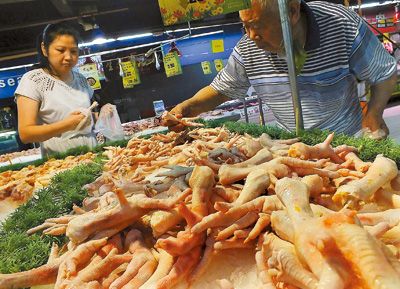
CHINA’S near two-year ban on U.S. imports of chickens used for breeding is threatening supplies of chicken meat in the world’s second-largest poultry market, leading to the first shortfall in at least a decade and potentially pushing up prices.
China relies on imported breeding stock for production of white-feathered broiler chickens, the type used by fast-food chains, which account for more than half the country’s chicken supply.
But the government banned poultry imports from the United States last year in response to a December 2014 bird flu outbreak.
That, followed by a similar ban on imports from France late last year, has seen a sharp drop in the supply of white-feathered “grandparent” stock.
Grandparent birds are the progeny of pedigree stock bred largely by three global companies, Aviagen, Cobb-Vantress and Groupe Grimaud. China has so far been unsuccessful in developing its own white-feathered pedigree lines.
Imports of breeding chicks — shipped in lots of 168 — fell to 720,000 units last year, around half the levels of 2013, said Fujian Sunner Development Co., a chicken supplier to Yum Brands’ KFC.
Only 110,000 units have entered the market so far this year, it added in its first-half report, well below what is needed to produce enough broiler chickens for next year’s demand.
The United States supplies about half of the world’s breeding chicks, followed by the United Kingdom. Only Spain and New Zealand, much smaller producers, can currently ship chicks to China.
“Even if the government lifts its bans by the end of the year, next year’s supply [of meat] wouldn’t recover,” said Pan Chenjun, senior analyst at Rabobank.
The World Organization for Animal Health declared the United States free of bird flu in April but China is yet to lift its ban.
Poultry prices have already been rising following a recent surge in prices of pork, China’s most popular meat.
That has pushed some consumers, such as school canteens, to buy more poultry, a cheaper substitute, helping the industry recover some demand after a protracted decline caused by food safety fears and China’s own outbreaks of bird flu.
A shortfall next year, forecast by Rabobank at around 1 million tons or 8 percent consumption, could push prices up by as much as 20 percent from a current 19.8 yuan (US$2.96) per kg, added Pan.
However, prices will be kept in check by alternatives such as duck meat and increased imports.
China will import 480,000 tons of poultry meat next year, up 33 percent from this year, from markets like Brazil, Argentina and Chile, said a recent report by U.S. agriculture department attaches in Beijing.
“Next year’s chicken price will certainly be higher than this year, but it will definitely be at an acceptable level,” said Huang Jianming, director of the China White-Feathered Chicken Alliance, adding that it wouldn’t rise high enough to spur substitution.
The situation, meanwhile, is offering temporary benefits for domestic poultry firms.
The price of parent stock, or birds bred from imported chicks that produce broiler chickens, has jumped tenfold in the past year to 45 yuan a package.
That helped Shandong Yisheng Livestock and Poultry, Asia’s top broiler breeder, generate first half profits of 270 million yuan, against losses of 192 million yuan a year ago.
The situation could also drive more consolidation in the industry, pushing out smaller players unable to get their hands on sufficient parent stock.
“In 2016 and 2017 supply in the white-feathered broiler sector is going to be damaged for quite a long period, and we expect the whole industry could see new opportunities in the next three years,” said Fujian Sunner.
(SD-Agencies)
|

